There's a reason why apex predators succeed in staying at the top of the food chain. Nature has moulded them into beasts that dominate everything around them. Well, Ducati and Triumph seem to have taken a crack at emulating nature by developing their own exquisite versions of such predators. Although apex predators may actively avoid coming face-to-face with each other in the wild, we've managed to get these two apex adventure tourers to battle it out in a competition of strength, versatility and value. So, let the wild games begin.
War paint
Both these motorcycles not only demand your attention, they command respect thanks to their magnificent sizes. In fact, I wouldn't be surprised if these two actually gave a few SUVs a complex. When you first approach the Enduro, that front facade is sure to catch your eye. Its bird-of-prey-like front beak and that set of dual headlights with the manually adjustable, high flyscreen are a signature of the Multistrada series, although the Enduro version gets an even bigger front beak. Look beyond that and the proportions start to take on a more gargantuan nature. The 30-litre, bulbous fuel tank sits authoritatively in the centre, and that is what really stands out on the Enduro. The curves blend so seamlessly with the edges, there's a nice, deep swoop into the seat. If anyone can make a purpose-built, adventure motorcycle look beautiful, it's got to be the Italians. The rest of the seat, the pillion seat, and the rear end are shared with the other Multistrada models.

The Tiger Explorer may not be the prettiest motorcycle out there but its menacing front facade with those large, dual headlights exudes a sense of purpose expected from an adventure motorcycle. The upswept, rugged jawline adds to its whole predatory appeal. It gets a tall, manually adjustable windscreen that is a bit difficult to operate. There are two knobs on either side of the fairing that need to be loosened before you can alter the height; so, adjusting the screen on the go will be impossible. It also gets these shrouded fog lights that sit below the fairing as a standard fitment, and really help with night riding, especially when off-roading.
Lethal gadgets
Just behind the windscreen of the Explorer is an LCD instrument cluster that uses handlebar-mounted thumb switches with the up/down scroll facility. Although, navigating through this menu is a bit of a complicated affair and can only be done when at a standstill. This 2014 version of the Explorer is a bit dated in terms of features and equipment when compared to the likes of the Multistrada Enduro. If you're not a big fan of electronic nannies, this could definitely work in your favour. You do get a three-stage traction control (off, 1 and 2) and switchable ABS, but that's about it. However, it misses out on more advanced electronics like power modes, a TFT screen and electronically adjustable suspension.
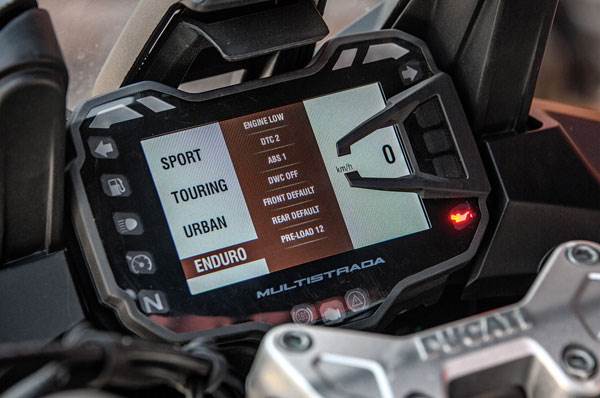
The Enduro, on the other hand, gets all the bells and whistles in terms of electronics. If you've ridden the other Multistrada models, the TFT instrument cluster is going to be rather familiar. It is well laid out, customisable, easy to read, and light-adaptive. But the Multistrada's party trick is its rider modes that can be easily accessed via the toggle buttons on the left switchgear. Once you get the hang of navigating through the menu, it's simply amazing how customisable the entire motorcycle is from just the cockpit. This is the top-of-the-line Multistrada model, so everything from your suspension to your engine character can be controlled electronically. The four basic rider modes – Sport, Touring, Urban and Enduro – can be switched when on the go. But when stationary, you can go into each mode and customise the character of the Enduro even further.
Besides the varying levels of power output, which are 160hp on high (Sport and Touring) and 100hp on low (Urban and Enduro), you get eight levels of traction control, wheelie control and ABS. Although, it must be noted that in Touring mode you get 100hp until the 4,000rpm mark, and from there on the full 160hp kicks in. There's also four settings available on Ducati's electronic Skyhook suspension, and 24 levels of preload. It's quite easy to filter through these options to make the Enduro ideal for the riding conditions and your level of skill. The motorcycle also gets Ducati's version of a hill-hold function, which releases the brakes gradually while stopped in Enduro mode.
The upswept silencer on the Explorer is humongous but gets a simple, sort of rectangular shape devoid of any drama. While viewing the profile of the Explorer, you realise the silencer is at an angle that is parallel to the bottom of the sub-frame and that lends a sort of flow into the minimalistic tail end. The grab rails are thick and it culminates in a vertical, twin-strip LED tail-light.
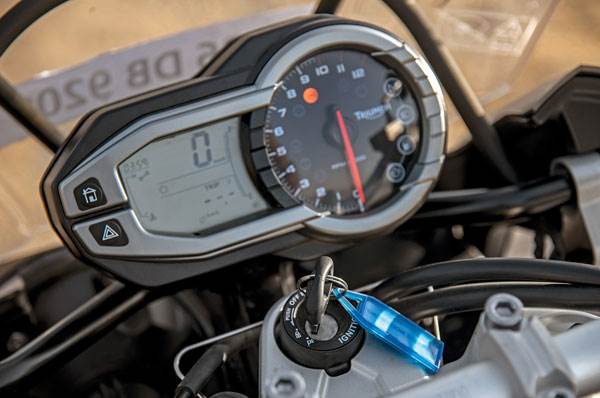
The Enduro simply towers over the other Multistrada models and is also a bit taller than the Tiger Explorer. Both motorcycles get spoked wheels with a larger 19-inch front tyre. These aren't just regular rims; if you look closely, you'll notice that the spokes sit on the outside of the rim on the Enduro and the Explorer gets steel spokes that sit on a rail on the aluminium rim, instead of the rim itself. Besides being very durable (and expensive), this feature is what allows these motorcycles to have tubeless tyres. The Enduro also gets a double-sided swingarm instead of the single-sided one, which obviously can take more of a beating and really helps with stability when riding off-road. The Enduro also gets a raised, side-slung, single exhaust that keeps in tune with the typically Ducati L-twin soundtrack.
The comfort zone
The Explorer gets an aggressive-looking, well-chiseled 20-litre tank, while the Enduro gets a massive 30-litre one. However, when the Enduro is fully tanked up, it has the tendency to feel a bit top-heavy. The Tiger 1200 Explorer XC is a vehemently large motorcycle, but once you get astride this beast, it's really not as intimidating as it appears. The seat is two-stage adjustable from 837mm to 857mm. At the lower 837mm setting, the seat doesn't really feel that tall. I'm about 5ft 10in and my feet were sitting flat on the ground – a definite bonus when moving such a large motorcycle around with the engine off. Once you get a move on, the seat feels extremely comfortable and well cushioned. There's a well-shaped taper to the front of the seat that allows you to grip the tank with your knees quite comfortably. The wide handlebars, however, do feel like a bit of a stretch thanks to the long tank. But once you get accustomed to this, you could ride for hours at triple-digit speeds. The tall, adjustable front windscreen shields you well from the wind blast that accompanies high speed.
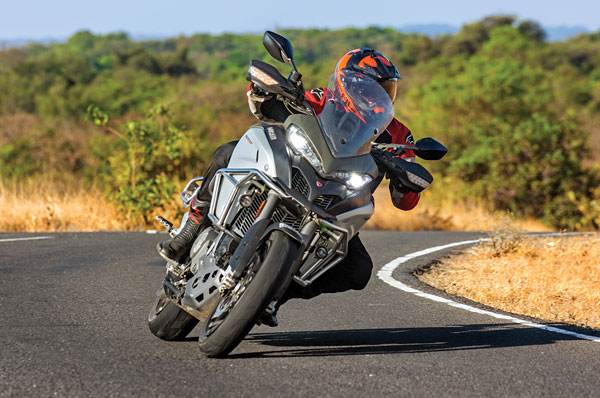
Enduro is definitely a bike for taller, bigger built riders. With a non-adjustable 850mm seat height, it's a bit of a daunting task getting astride (there are even taller options available at 870mm and 890mm). But once you get on, you're sitting well inside the bike. The seat is enormously comfortable. The handlebars are nice and wide, and the front visor is manually adjustable and easy to use. And once you get it all the way up, the wind protection is just brilliant. Just a slight tuck in and you can hold this position all day with minimal fatigue from windblast. If you start to get a bit tired, all you have to do is stand up. The spiked pegs hold your feet in place brilliantly, and the tank has just the right contours to squeeze in your knees. The standing position on the Enduro feels so natural, you could probably stand and ride the entire day.
Heavy ammunition
The Enduro gets Ducati's Testastretta DVT (Desmodromic Valve Timing) engine which has immediate benefits on road and off. The engine pulls smoothly from 2,000rpm, ensuring you don't have to shift the gears much. However, as with all Ducatis, you really have to keep an eye out for the false neutrals between fourth, fifth and sixth gears. The throttle response is sharp and power feels good as the revs climb, with the bike pulling noticeably harder at around the 6,000rpm mark. But it must be noted that the fuelling did feel a bit jerky in Urban mode. The 160hp produced is more than enough grunt for a motorcycle this large. Although, when off road, having it in Enduro mode with power limited to 100hp is definitely advisable. It's more than enough power needed while in the dirt.
The heart and soul of the Tiger, however, is its motor. The fuel-injected 1,213cc engine has double overhead cams, with an inline triple-cylinder layout and ride-by-wire throttle. The 137hp of peak power and 121Nm of torque is directed to the rear wheel via a shaft drive that is not only durable, but also much lower on maintenance than a regular chain drive. This results in an extremely sharp throttle response that's great for the road. But couple this up with the absence of power modes and it can complicate things a bit when riding in the dirt, although the traction control does smooth things out a bit. There's a deep howl from the inline-triple, providing you with a pretty affable soundtrack. The torque is spread well across the rev range and pulling away from speeds as low as 25kph in third gear means you don't have to work through the six-speed gearbox as much as you'd need to on the Enduro. If you decide to push the motorcycle, you'll notice that it has a very strong and linear mid-range that tapers off into a not-so-punchy top end. But, all in all, this is a very tractable motor.
Into the wild
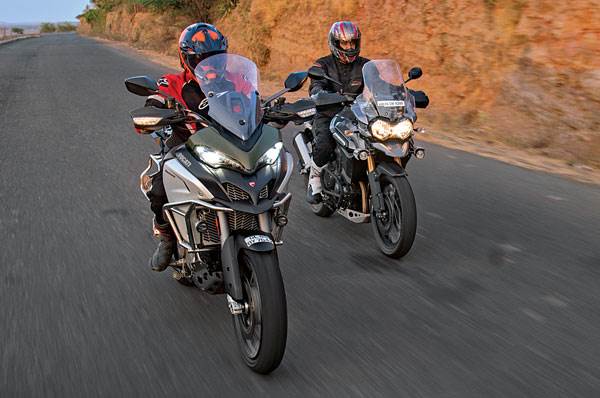
Despite the Explorer being an absolutely brilliant companion for the highway, its off-road credentials are a bit more subdued. First, the handlebar tends to feel a bit low when you're in the standing position. Second, the throttle feels way too sharp for off-roading, although the traction control does iron this out considerably. Finally, this motorcycle weighs a whopping 259kg and this weight is obvious when out on the dirt. So, even though the Explorer is capable of some amount of trail riding, you and the motorcycle would be happiest out on wide open stretches of highway – it is definitely a road-biased machine. Set the suspension up on the stiffer side and the Explorer will conquer twisties effortlessly, dipping in with poise. It feels decently sporty when you hit the bends.
The crowning glory of the Multistrada is how well it changes its character depending on the riding modes. Once you get moving, premonitions of it being a ridiculously large motorcycle start to fade. It, in fact, is extremely manageable and rider friendly. Here's where you get to explore the beauty of the different modes. In Urban mode, the Enduro feels a bit underpowered, but this should be good for wet riding conditions. The fuelling feels a bit jerky as well. The big problem here, however, is the amount of heat generated in slow-moving traffic. The larger tank restricts the flow of air around the engine and ends up sending searing levels of heat towards your left thigh. Although, a short blast into triple-digit speeds does see the temperature drop.
In Touring mode, the suspension feels soft and beautifully absorbs bumps at all speeds. However, in the corners, it does tend to lollop around over bumps and that hampers precision. In Sport mode, the Enduro changes from a more relaxed nature to a very crisp one. Although the suspension is still a bit soft, the bike encourages you to push it harder. It tips into and tackles corners with poise and precision; not something you'd expect from such a large motorcycle. And even with the upright riding position, it could certainly give sportier machines a run for their money.
But it's the Enduro mode that sets this Multistrada apart. It just makes the motorcycle so much fun on dirt! However, a lot of muscle power is required here. With the ABS set at level one, the front ABS remains active while the rear switches off and allows you to lock up, square-off and tighten turns. Of course, I did end up finding the traction control a bit intrusive when trying to get the rear sliding, but that was sorted out by switching traction control off altogether. If you know what you're doing, this motorcycle could do trails all day. It would still be way too heavy for the more technical stuff but the Enduro does trump the Explorer in the handling department, thanks to its highly adaptable nature.
The world is your oyster
The Tiger 1200 Explorer XC is a genuinely likeable, rider-friendly motorcycle. It will get you across massive distances in utmost comfort as expected from a premium adventure tourer. But that's just about how far the ball goes. It falls woefully behind in terms of equipment when compared to the more recently updated competition. Which isn't really a deal-breaker per se; it just isn't as capable as the Multistrada. The beautiful part about the Enduro is just how easy it is to ride, despite its gargantuan proportions. But this is not a motorcycle for just anybody and definitely not a motorcycle for the city. Even if it falls within your budget and you're large enough to manage its size, you also need the kind of skills to really appreciate what it is really capable of.
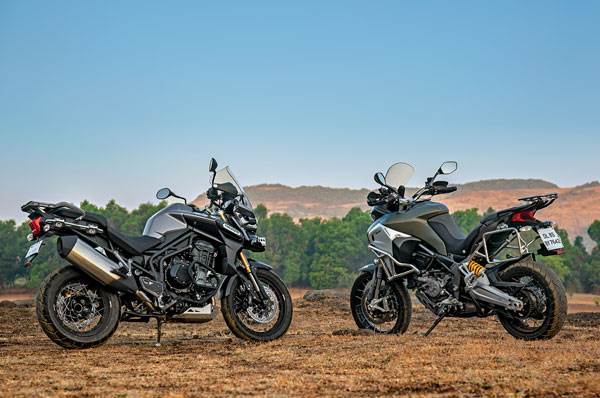
The Explorer is more of the old-school charmer that will provide you with hours of carefree comfort and blissful riding on the highway. The Enduro, on the other hand, is a raging bull that's hiding silently, constantly egging you to wring out its full potential. The Enduro and its rider would probably view the entire world's terrain as a challenge waiting to be conquered. Given that attitude and its mind-boggling potential, we pick it over the Explorer. But we're also aware that not everyone would demand that sort of potential from a motorcycle and not everybody is a great fan of dirt-riding or adrenaline surges. And the Explorer is right there to satiate the needs of the motorcyclists who aren't big fans of electronics and tend to see this world in more subdued way. Well, to each his own.

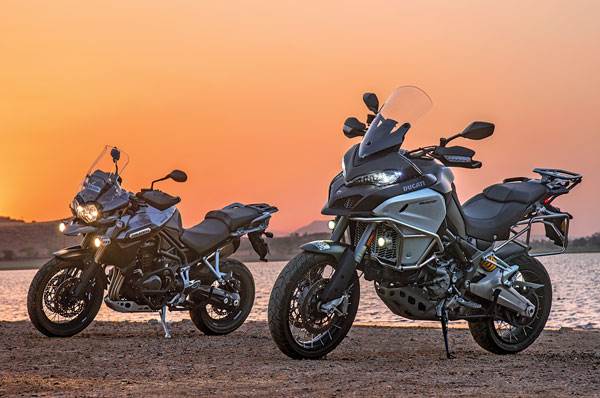
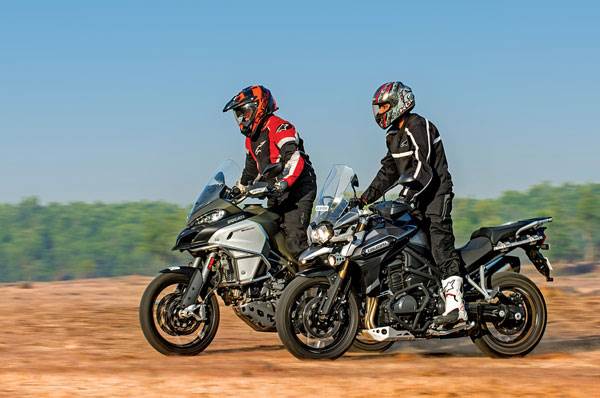




Comments
Member Login
Personal Details
No comments yet. Be the first to comment.